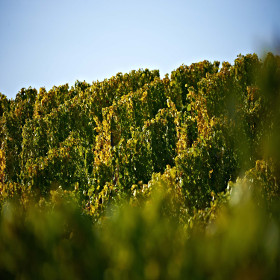





Weingut Fuchs
Hans-Jakob Fuchs
Burggasse 1
67592 Flörsheim-Dalsheim




The location was 1490 to 1525 with the name "in the Sawloch" documented. Domestic or wild boars wallowed in this mud in the mud.

Devotional, romantic or humorous?
The location was mentioned in a document in 1750 with the name "in the rose garden". The planting of the noble flower, the rose, may have led to its name. Often, however, these vineyard anmen point to early medieval burial sites. Which of these is true, we do not know today. But the single vineyard is quite romantic today in spring - with pink blossoming almond trees. And is adorned by two trulli, small white round houses. The radio tower trullo looks particularly funny. A funny architectural ensemble of brick on the one hand and a steel construction on the other. A bench and a round table invite you to rest under the trees. The "Pfrimm", a small river (the locals say "the Bach") flows by not far away. Monsheim and Kriegsheim (a district of Monsheim) have over 20 bridges. A wide variety of grape varieties grow on loess soil with sand, gravel and clay portions. The vineyard can be found under the name "Monsheimer Rosengarten" as well as "Kriegsheimer Rosengarten".
> Discover Monsheim via hiking trail "Zellertalweg", circular trail Monsheim - Mölsheim - Wachenheim. https://www.rheinhessen.de/zellertalweg-rundweg-monsheim#dmdtab=oax-tab1
> More impressions in the blog post: https://blog.rheinhessen.de/der-zellertalweg-rundweg-monsheim-moelsheim-wachenheim/
> Other single vineyards in Rheinhessen with the same name: Gabsheimer Rosengarten or Bechtheimer Rosengarten.


Pinot wines and sparkling wines at the Fleckenmauer
The single vineyard "Bürgel" is located by the famous Fleckenmauer. The vineyard was first noted in 1286 with the name "retro montem" (Latin: retro for behind, and mons for mountain). A hundred years later, in 1358, someone wrote down "uf dem berge"(engl. “on the mountain”), which became "Bürgel". Pinot grape varieties like Pinot Gris, Blanc and Noir grow especially well here. In addition to fertile loess and marl soil, the ochre-coloured limestone "terra fusca" is decisive for the quality. Not only for top wines, but also for sparkling wines. Therefore it is not surprising that the 1,100-metre-Fleckenmauer was built with limestone. It is the only medieval wall of this magnificence preserved in Rheinhessen.

Of nuns and damsels
Women were once in charge here: the site was first mentioned in a document in 1290 with the name "an frauwenhalten". Originally, the hill was owned by a nunnery. Riesling and Pinot Noir vines grow on loess and limestone. Benches and a table at the "Fräulein von Flersheim" trullo can be used for a rest. In summer, roses bloom lushly there. The red vineyard hut at the Goldbergbrunnen is partly catered for.
> Info about the trullo "Fräulein von Flersheim", owned by Weingut Beyer-Bähr: https://www.tourenplaner-rheinland-pfalz.de/de/punkt/veranstaltungsort/weinbergshaeuschen-trullo-frl.-v.-flersheim/54980916/
> Info about the Wingertheisje at the Goldbergbrunnen: https://tacheles-landrestaurant.de/wingertsheisje/
> To all hiking and biking tours of Flösrheim-Dalsheim: https://www.floersheimdalsheim.de/og/freizeit-tourismus/rad-wandern-gps-touren/

Of hooves and limestone rocks - a Riesling prime vineyard
In the past, farmers farmed their land with horses or oxen. The term "Hufe" or "Huffe" was a unit of measurement for a piece of land. In 1490, it was noted that 5 Hufen were worth 5 Mausi (a payment). The term "Hube" developed from "Hufe". In 1610, the location "am Hubacker" was mentioned in a document for the first time. Here Riesling grows on loess, clay marl and limestone rock. Expressiveness, filigree, minerality and ripeness potential at the highest level! In 2000, the Keller family of winegrowers built a 6.5-metre-high limestone tower there. A beautiful destination for an excursion!
